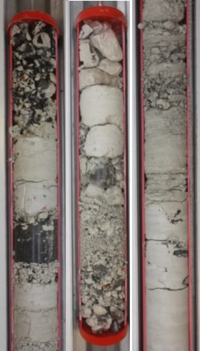Difference between revisions of "Physical processes and governing equations"
m (→Physical processes) |
m (→Contaminant transport) |
||
| Line 17: | Line 17: | ||
=== Contaminant transport === | === Contaminant transport === | ||
To describe the transport of a substance in a porous medium, the advection-dispersion equation is usually employed. | To describe the transport of a substance in a porous medium, the advection-dispersion equation is usually employed. | ||
| − | + | The first term describes storage (here including retardation due to linear sorption), the second and third terms describe advective and dispersive transport of a substance. | |
| − | + | Degradation can be included as additional term. | |
[[File:TransportEquation.png|280px|frameless|The transport equation for an equivalent porous medium model.]] | [[File:TransportEquation.png|280px|frameless|The transport equation for an equivalent porous medium model.]] | ||
Revision as of 14:37, 11 January 2017
Contents
Physical processes
Transport of substances in porous media can be subdivided in advective transport (due to the groundwater flow) and diffusive/dispersive transport. The storage of substances is strongly influenced by sorption of the substance to the porous medium. This is often quantified as retardation, using a retardation factor.
Fractured limestone has usually a strong contrasting flow conditions between fractures and matrix. The fractures can have very high flow velocities mainly depending on their aperture (width), whereas the limestone matrix has usually a very low hydraulic conductivity and thus low flow velocities. However, for the fate of contaminants in fractured limestone aquifer, the matrix is important, since it usually has a high porosity and can store substantial amounts of contaminants, once they have diffused into the matrix.
Governing equations
Flow
Groundwater flow in porous media is usually described by Darcy's law, giving a relation between hydraulic head gradient and groundwater flow. The fracture conductivity is usually determined via the fracture aperture using the cubic law.
Flow equation.
Contaminant transport
To describe the transport of a substance in a porous medium, the advection-dispersion equation is usually employed. The first term describes storage (here including retardation due to linear sorption), the second and third terms describe advective and dispersive transport of a substance. Degradation can be included as additional term.
Properties of limestone
Limestone can be heavily fractured and include almost impermeable chert layers and nodules. The limestone found at the Akacievej site (Copenhagen kalk and bryozoan limestone) has a strongly varying hardness.
The sorption behavior for chlorinated solvents on limestone was examined in Salzer (2013). For chlorinated solvents like PCE, sorption to limestone can be strong (kd values of 0.5-1 L/kg were observed).
Return to Content
